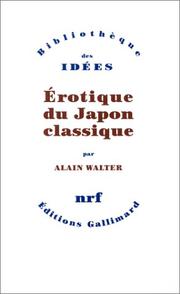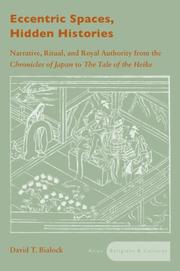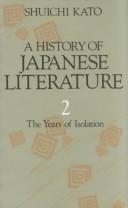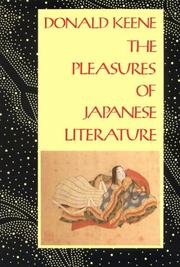| Listing 1 - 10 of 13 | << page >> |
Sort by
|
Book
ISBN: 9782850830167 285083016X Year: 2020 Volume: [55] 80 Publisher: Paris: Le point,
Abstract | Keywords | Export | Availability | Bookmark
 Loading...
Loading...Choose an application
- Reference Manager
- EndNote
- RefWorks (Direct export to RefWorks)
Qu’est-ce qui caractérise le mieux le Japon aux yeux d’un Occidental ? Ses geishas, ses pagodes, ses ponts voûtés dans des jardins moussus aux couleurs d’automne, ses samouraïs, ses mangas, ses sushis, les romans de Murakami ? De tous les pays asiatiques le Japon est celui qui a le plus influencé l’Occident. Mais que connaît-on vraiment de sa culture, de ses croyances, de ses icônes ?Le Point Références vous invite à découvrir cet archipel qui n’a cessé de surprendre. Comment un pays encore féodal a-t-il réussi, en moins de trente ans, à se moderniser suffisamment pour prétendre attaquer la Chine, la pesante puissance voisine et, dans la foulée, l’Empire russe ? Pourquoi plonge-t-il alors dans une dictature mystique centrée sur la guerre de l’empereur ? Pourquoi est-ce la femme de cour qui fait du japonais une langue littéraire ? Autant d’énigmes que la lecture des textes considérés comme des classiques par les Japonais aide, peut-être, à résoudre.De dame Shônagon à Yasushi Inoue, des palais Heian et de Kyoto aux buildings de Tokyo, ce hors-série vous entraîne dans une balade entre roman, haïku spectacle nô et philosophie, où les dramaturges écrivent pour des marionnettes, les moines composent des poèmes, les philosophes se dopent à la physique quantique et les femmes, toujours les femmes, sont les maîtresses de l’érotisme.
Book
ISBN: 0691066353 Year: 1985 Publisher: Princeton Princeton university press
Abstract | Keywords | Export | Availability | Bookmark
 Loading...
Loading...Choose an application
- Reference Manager
- EndNote
- RefWorks (Direct export to RefWorks)
J5500.10 --- J5509 --- Japanese literature --- -Japan: Literature -- history and criticism -- premodern, ancient and earliest --- Japan: Literature -- theory, methodology and philosophy --- History and criticism --- Theory, etc. --- Congresses. --- History and criticism&delete& --- Theory, etc --- Congresses --- Japan: Literature -- history and criticism -- premodern, ancient and earliest

ISBN: 2070732177 9782070732173 Year: 1994 Volume: *22 Publisher: Paris Gallimard
Abstract | Keywords | Export | Availability | Bookmark
 Loading...
Loading...Choose an application
- Reference Manager
- EndNote
- RefWorks (Direct export to RefWorks)
Erotica --- Eroticism --- Erotiek --- Erotisme --- J5500.10 --- Japan: Literature -- history and criticism -- premodern, ancient and earliest --- Erotic literature, Japanese --- Japanese literature --- Japanese erotic literature --- History and criticism --- Sex customs --- Japan --- History

ISBN: 0804751587 9780804751582 0804767645 1435608801 9781435608801 Year: 2007 Publisher: Stanford, Calif. : Stanford University Press,
Abstract | Keywords | Export | Availability | Bookmark
 Loading...
Loading...Choose an application
- Reference Manager
- EndNote
- RefWorks (Direct export to RefWorks)
After 'The Tale of Genji' (c.1000), the greatest work of classical Japanese literature is the historical narrative 'The Tale of the Heike' (13th-14th centuries). In addition to opening up fresh perspectives on the Heike narratives, this study draws attention to a range of problems centred on the interrelationship between narrative, ritual space, and Japan's changing views of China as they bear on depictions of the emperor's authority, warriors, and marginal population going all the way back to the Nara period.
History in literature. --- Japanese literature --- Religion and literature --- History and criticism. --- Heike monogatari. --- J5500.10 --- J5920 --- Literature --- Literature and religion --- Japan: Literature -- history and criticism -- premodern, ancient and earliest --- Japan: Literature -- premodern fiction and prose ( -1868) --- Moral and religious aspects --- Tale of the Heike --- 平家物語 --- History in literature --- History and criticism

ISBN: 0870114913 9780870114915 0333198824 Year: 1979 Publisher: London Macmillan
Abstract | Keywords | Export | Availability | Bookmark
 Loading...
Loading...Choose an application
- Reference Manager
- EndNote
- RefWorks (Direct export to RefWorks)
Japanese literature --- Japanese literature. --- History and criticism. --- -Japanse literatuur --- 895.6 --- J5500 --- J5500.10 --- J5500.40 --- -895.6 Japanse literatuur --- Japanse literatuur --- Japan: Literature -- general, history and criticism --- Japan: Literature -- history and criticism -- premodern, ancient and earliest --- Japan: Literature -- history and criticism -- Kamakura period, Yoshino (1185-1392) and Chūsei in general (1185-1600) --- History and criticism --- -History and criticism
Book
ISBN: 0691101469 0691053790 0691629145 0691612455 Year: 1983 Publisher: Princeton (N.J.) : Princeton university press,
Abstract | Keywords | Export | Availability | Bookmark
 Loading...
Loading...Choose an application
- Reference Manager
- EndNote
- RefWorks (Direct export to RefWorks)
This book, which covers the period from preliterate times to the beginning of the tenth century, is the first of five proposed volumes that will give an account of Japanese literature from its beginnings to the death of the modern novelist Mishima.Originally published in 1984.The Princeton Legacy Library uses the latest print-on-demand technology to again make available previously out-of-print books from the distinguished backlist of Princeton University Press. These editions preserve the original texts of these important books while presenting them in durable paperback and hardcover editions. The goal of the Princeton Legacy Library is to vastly increase access to the rich scholarly heritage found in the thousands of books published by Princeton University Press since its founding in 1905.
J5500 --- J5500.10 --- J5500.40 --- Japan: Literature -- general, history and criticism --- Japan: Literature -- history and criticism -- premodern, ancient and earliest --- Japan: Literature -- history and criticism -- Kamakura period, Yoshino (1185-1392) and Chūsei in general (1185-1600) --- Knowledge, Theory of --- Epistemology --- Theory of knowledge --- Philosophy --- Psychology --- History --- England --- Intellectual life --- Théorie de la connaissance --- Histoire --- Angleterre --- Vie intellectuelle --- Japanese literature --- History and criticism.
Book
ISBN: 9782913217201 Year: 2009 Publisher: Paris Collège de France, Institut des hautes études japonaises
Abstract | Keywords | Export | Availability | Bookmark
 Loading...
Loading...Choose an application
- Reference Manager
- EndNote
- RefWorks (Direct export to RefWorks)
Calligraphy, Japanese --- Japanese language --- Lacquer and lacquering --- Narrative painting, Japanese --- Painting, Japanese --- Scrolls, Japanese --- J5500.10 --- J5700 --- J6008.10 --- J6100 --- J6280 --- J6290 --- Inscriptions on Japanese paintings --- Inscriptions --- Middle Japanese language --- History --- Japan: Literature -- history and criticism -- premodern, ancient and earliest --- Japan: Literature -- poetry in general --- Japan: Art and antiquities -- history -- Kodai, prehistoric and ancient, premodern --- Japan: Art and antiquities -- calligraphy --- Japan: Art and antiquities -- painting and drawing -- other schools, independent --- Japan: Art and antiquities -- painting and drawing -- type and form -- illustrative works
Book
ISBN: 1283261057 9786613261052 0231527195 9780231527194 9781283261050 0231153961 023115397X 9780231153966 9780231153973 661326105X Year: 2011 Publisher: New York : Columbia University Press,
Abstract | Keywords | Export | Availability | Bookmark
 Loading...
Loading...Choose an application
- Reference Manager
- EndNote
- RefWorks (Direct export to RefWorks)
Finding Wisdom in East Asian Classics is an essential, all-access guide to the core texts of East Asian civilization and culture. Essays address frequently read, foundational texts in Chinese, Japanese, Korean, and Vietnamese, as well as early modern fictional classics and nonfiction works of the seventeenth century. Building strong links between these writings and the critical traditions of Confucianism, Buddhism, and Daoism, this volume shows the vital role of the classics in the shaping of Asian history and in the development of the humanities at large.Wm. Theodore de Bary focuses on texts that have survived for centuries, if not millennia, through avid questioning and contestation. Recognized as perennial reflections on life and society, these works represent diverse historical periods and cultures and include the Analects of Confucius, Mencius, Laozi, Xunxi, the Lotus Sutra, Tang poetry, the Pillow Book, The Tale of Genji, and the writings of Chikamatsu and Kaibara Ekken. Contributors explain the core and most commonly understood aspects of these works and how they operate within their traditions. They trace their reach and reinvention throughout history and their ongoing relevance in modern life. With fresh interpretations of familiar readings, these essays inspire renewed appreciation and examination. In the case of some classics open to multiple interpretations, de Bary chooses two complementary essays from different contributors. Expanding on debates concerning the challenges of teaching classics in the twenty-first century, several pieces speak to the value of Asia in the core curriculum. Indispensable for early scholarship on Asia and the evolution of global civilization, Finding Wisdom in East Asian Classics helps one master the major texts of human thought.
East Asian literature --- Wisdom in literature. --- Best books --- Canon (Literature) --- Classics, Literary --- Literary canon --- Literary classics --- Criticism --- Literature --- Best-book lists --- Bibliography --- Book lists --- Recommended books --- Books --- Book selection --- History and criticism. --- History and criticism --- Wisdom in literature --- S12/0200 --- S16/0150 --- China: Philosophy and Classics--General works --- China: Literature and theatrical art--General works --- J5500.10 --- K9700.10 --- Japan: Literature -- history and criticism -- premodern, ancient and earliest --- Korea: Literature -- history -- ancient, premodern

ISBN: 9780231067362 9780231067379 0231067364 Year: 1988 Publisher: New York: Columbia university press,
Abstract | Keywords | Export | Availability | Bookmark
 Loading...
Loading...Choose an application
- Reference Manager
- EndNote
- RefWorks (Direct export to RefWorks)
Perhaps no one is more qualified to write about Japanese culture than Donald Keene, considered the leading interpreter of that nation's literature to the Western world. The author, editor, or translator of nearly three dozen books of criticism and works of literature, Keene now offers an enjoyable and beautifully written introduction to traditional Japanese culture for the general reader.The book acquaints the reader with Japanese aesthetics, poetry, fiction, and theater, and offers Keene's appreciations of these topics. Based on lectures given at the New York Public Library, The Metropolitan Museum of Art, and the University of California, Los Angeles, the essays -though written by a renowned scholar- presuppose no knowledge of Japanese culture. Keene's deep learning, in fact, enables him to construct an overview as delightful to read as it is informative.His insights often illuminate aspects of traditional Japanese culture that endure today. One of these is the appreciation of "perishability." this appreciation os seen in countless little bits of Japanese life: in temples made of wood instead of durable materials; in the preference for objects -such as pottery- that are worn, broken, or used rather than new; and in the national love of the delicate cherry blossom, which normally falls after a brief three days of flowering. Keene quotes the fourteenth-century Buddhist monk Kenko, who wrote that "the most precious thing about life is its uncertainty."Throughout the volume, Keene demonstrates that the rich artistic and social traditions of Japan can indeed be understood by readers from our culture. This book will enlighten anyone interested in Japanese literature and culture.
J5500.10 --- J6800.10 --- J6020 --- J5920 --- Japanese literature --- -Theater --- -Aesthetics, Japanese --- Japanese aesthetics --- Dramatics --- Histrionics --- Professional theater --- Stage --- Theatre --- Performing arts --- Acting --- Actors --- Japan: Literature -- history and criticism -- premodern, ancient and earliest --- Japan: Performing and media arts -- history -- earliest and premodern --- Japan: Art and antiquities -- Japanese aesthetics (Japonism) --- Japan: Literature -- premodern fiction and prose ( -1868) --- History and criticism --- History --- Japanese literature - To 1868 - History and criticism --- Theater - Japan - History --- Aesthetics, Japanese --- Theater --- Aesthetics, Japanese. --- History and criticism. --- History.
Book
ISBN: 9782913217423 2913217427 Year: 2021 Publisher: Paris: Collège de France. Institut des hautes études japonaises,
Abstract | Keywords | Export | Availability | Bookmark
 Loading...
Loading...Choose an application
- Reference Manager
- EndNote
- RefWorks (Direct export to RefWorks)
Le colloque « Hiéroglossie II : Les textes fondateurs » qui s’est tenu au Collège de France les 8 et 9 juin 2016 se proposait de poursuivre l’examen du phénomène de hiérarchisation des langues conçue comme l’un des facteurs dynamiques de leur histoire, puisque toute hiérarchisation a pour destin d’être remise en question. L’établissement d’un texte sacré est sans doute un élément primordial dans la constitution d’un réseau hiéroglossique, mais il existe des textes qui, sans s’être vu conférer la dignité de sacrés, peuvent cependant être considérés comme le point de départ d’une tradition langagière répétant, dans un autre ordre, un processus analogue à ce qui s’est passé dans le domaine religieux avant de s’étendre à l’ensemble d’une culture.Ici encore, la plus grande liberté a été laissée aux participants pour proposer leur propre vision d’un texte fondateur. Si certains choix s’admettent naturellement, d’autres sont plus inattendus, mais toutes les contributions montrent l’importance décisive d’un texte référentiel comme médiation d’un destin langagier. Le Kojiki est le garant a posteriori de l’indépendance de la langue japonaise, le Beowulf anglo-saxon est remis à l’honneur grâce au succès du Seigneur des anneaux, qui s’est lui-même inspiré du Kalevala finnois, jusque dans l’élaboration de langues imaginaires.Chacune des treize contributions propose ainsi une manière d’aborder les grands et moins grands textes dans une perspective dynamique d'ouverture sur l’histoire des langues.
Language and culture --- Literature --- History and criticism --- J5500.10 --- J1912.10 --- J5920 --- S12/0350 --- Japan: Literature -- history and criticism -- premodern, ancient and earliest --- Japan: Religion -- Shintō -- sacred writings, teachings -- histories, mythologies --- Japan: Literature -- premodern fiction and prose ( -1868) --- China: Philosophy and Classics--Chunqiu 春秋 Spring and Autumn Annals, Zuozhuan 左傳 --- Language and culture - Japan - Congresses --- Language and culture - China - Congresses --- Language and culture - Europe - Congresses --- Literature - History and criticism - Congresses
| Listing 1 - 10 of 13 | << page >> |
Sort by
|

 Search
Search Feedback
Feedback About UniCat
About UniCat  Help
Help News
News